Fisheries Habitat Restoration Program
North Coast Local Land Services has received funding under the Australian Government’s Fisheries Habitat Restoration Program to deliver projects to restore the health and functionality of fisheries habitat across the region.
These projects will address key threats to fisheries habitat on the North Coast. This includes:
- historical clearing of the vegetation adjacent to waterways which has led to habitat loss and water degradation.
- riverbank erosion caused by the lack of vegetation, land management practices and wave action due to boat wash.
Fisheries habitat restoration plays a vital role in maintaining the health and sustainability of marine ecosystems. Over the years, human activities, such as pollution, overfishing, and habitat destruction, have taken a toll on fish populations and their habitats. By restoring these habitats, we can reverse some of the damage done and ensure the long-term viability of our rivers and oceans.
The Importance of Habitat Restoration
Biodiversity Preservation:
Healthy fish habitats support a rich diversity of species, providing essential breeding, feeding, and sheltering grounds. By restoring these habitats, we create conditions conducive to the recovery of various fish species, including those that are economically and ecologically valuable.
Ecosystem Resilience:
Restored fisheries habitats enhance the overall resilience of marine ecosystems. By creating a more balanced and interconnected habitat network, we strengthen the food web, promote population stability, and increase the ecosystem's ability to withstand environmental changes and disturbances.
Economic and Social Benefits:
Thriving fish populations resulting from habitat restoration efforts have numerous economic and social benefits. They support sustainable fisheries, contributing to the livelihoods of fishing communities and ensuring a stable supply of seafood for consumers. Additionally, healthy fish populations can boost tourism and enhance recreational activities
Our Restoration Initiatives:
NCLLS worked together with our valued partners: Byron Shire Council, Tweed Shire Council, Nambucca Shire Council, OzFish Unlimited, Nambucca Landcare and private landholders to deliver a range of actions to address key threats to fisheries habitat in the North Coast including:
Bank Stabilisation
Across three projects in Nambucca, Tweed, and Byron Shires composite log-rock revetment bank stabilisation works were installed to provide bank stability and areas of intertidal vegetation.
- 1.2km along the Nambucca River
- 500m along the Tweed River
- 160m along the Brunswick River
Habitat Rehabilitation:
- 25 Reef balls were installed into Emigrant creek to serve as a shelter and nursery for juvenile fish and provide hiding places, feeding grounds, and breeding sites for a variety of fish species, promoting biodiversity and supporting local fisheries
- Installation of root balls and snags along the Nambucca and Tweed rivers to provide immediate fish habitat
- Creating mangrove recruitment areas by trapping sediment and creating a nursery for mangrove propagules
Rehabilitating Riparian Vegetation
Across all 5 projects, riparian areas have been rehabilitated via revegetation, weed control, and stock exclusion works.
- 5.5ha along Emigrant Creek
- 0.5ha along the Tweed River
- 0.3ha along the Brunswick River
- 0.75ha along the Richmond River
- 2.36ha along the Nambucca River
Byron
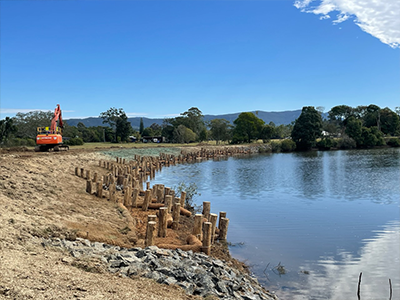
160m of riverbank along the Brunswick River has been rehabilitated to improve fish habitat. The project is designed to result in an increase in fish stocks in the Upper Brunswick Estuary and involved the installation of composite timber and rock structures to help stabilise the bank and create fish aggregation structures.
The structures will also act as a mangrove recruitment area by trapping sediment and creating a nursery for mangrove propagules. Mangroves can play a significant role in bank stabilisation structures due to their unique ecological characteristics. The extensive root systems of mangroves provide excellent anchorage and stability to shorelines, protecting them from erosion caused by wave action and tidal forces.
Nambucca
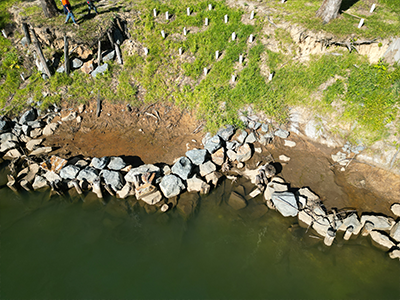
Works included installing a mix of contemporary bank stabilisation techniques such as revetment, rock fillets and root balls to protect the riverbank from erosion and provide vital instream habitat for fish and encourage the natural recovery of mangroves.
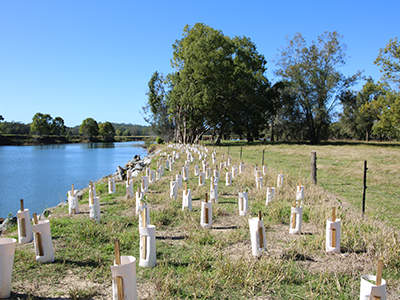
Fencing off waterways to keep cattle out of rivers and streams, and revegetating the area to increase bank stability, provide bank structure and increase important vegetation communities.
Emigrant
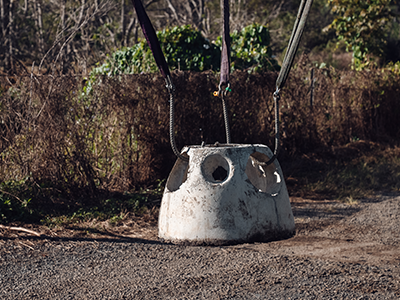
Reef balls are made from a specially formulated concrete that is environmentally friendly and resemble a hollow dome with holes and notches. The hollow interior serves as a shelter and nursery for juvenile fish and provides hiding places, feeding grounds, and breeding sites for a variety of fish species, promoting biodiversity and supporting local fisheries.
Tweed
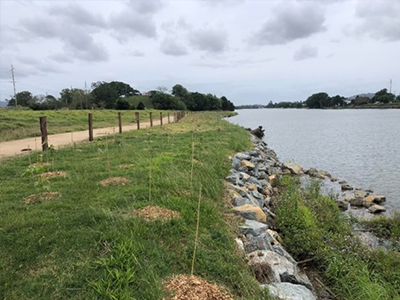
550m of riverbank along the Tweed River have been rehabilitated to improve fish habitat. The project used large eucalypt root balls and logs and embedded them into the riverbank to create snags and areas of intertidal vegetation. Whilst rock revetment, riparian plantings and cattle exclusion fencing were used to help stablise the bank and restore riparian function.
The restoration of fisheries habitats is a crucial step towards preserving marine biodiversity, ensuring the resilience of ecosystems, and supporting the well-being of coastal communities.
This project is part of the Fisheries Habitat Restoration Program in which North Coast Local Land Service will deliver five projects to restore the health and functionality of fisheries habitats across the region.